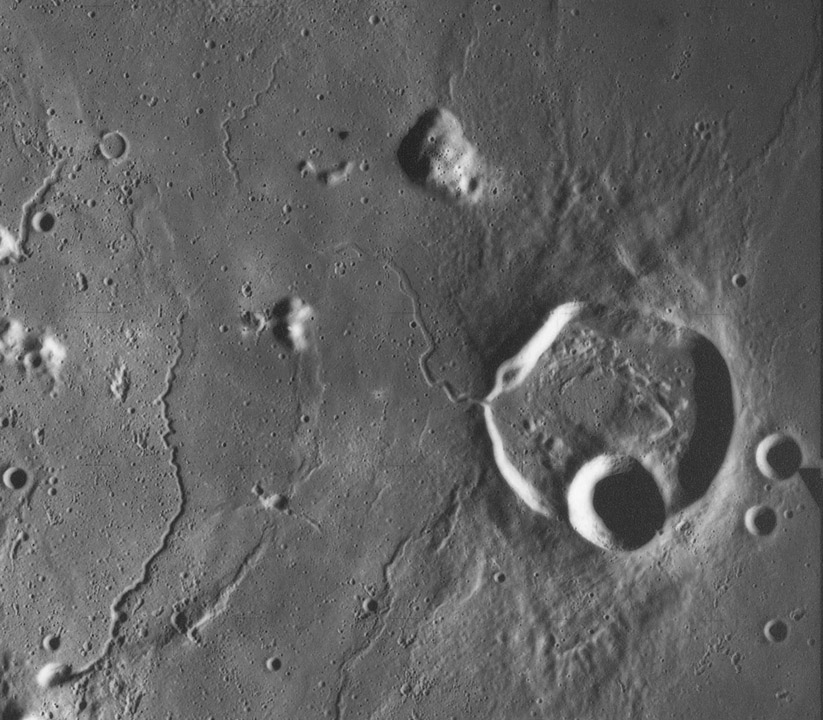|
|
| (4 intermediate revisions by the same user not shown) |
| Line 1: |
Line 1: |
| | __NOTOC__ | | __NOTOC__ |
| | =An Invisible Lava Flow= | | =An Invisible Lava Flow= |
| | + | <!-- Start of content --> |
| | <div class="post" id="post-1351"> | | <div class="post" id="post-1351"> |
| | | | |
| Line 6: |
Line 7: |
| | <p>[[File:Krieger&RilleLPODAS15-M2480.jpg|Krieger&RilleLPODAS15-M2480.jpg]]<br /> | | <p>[[File:Krieger&RilleLPODAS15-M2480.jpg|Krieger&RilleLPODAS15-M2480.jpg]]<br /> |
| | <em>Apollo 15 photograph from LPI [http://www.lpi.usra.edu/resources/apollo/ Apollo Image Atlas ]</em></p> | | <em>Apollo 15 photograph from LPI [http://www.lpi.usra.edu/resources/apollo/ Apollo Image Atlas ]</em></p> |
| − | <p>Here is a remarkable piece of evidence about lava flows on the Moon - do you see it? The 22 km wide crater is [http://the-moon.wikispaces.com/Krieger Krieger] with the fresh crater Van Biesbroeck on its rim (remind me to tell you about Van-B, a wonderful little man). The interior of Krieger is unusual, its has a central tilted plateau which is surrounded by strange little hills that don’t look like rim debris. What is perhaps most unusual is the notch on the west rim and the rille that starts there and extends about 20 km to the northwest. Like many of the rilles in this Aristarchus-Prinz region, the [http://the-moon.wikispaces.com/Rima+Krieger Krieger Rille] has abrupt right angle bends, as if a plumber designed it. I think that a pond of lava within Krieger drained through the rim notch, creating the rille which distributed lava out onto the mare. Did you notice the rille at bottom left - its one of the Aristarchus Rilles - #VI according to the old <em>System of Lunar Craters</em> map [http://www.glrgroup.org/domes/mapdome/f3.htm F3]. VI ends, but then appears to begin a few kilometers further north. The idea that sinuous rilles (or orthogonal ones like the Krieger Rille) transport lava always leads doubters to question, where did the lava go? Here we can see that it spread out in a layer thick enough to cover #VI. And notice that the area around the rille has fewer impact craters, is darker and a smoother surface - it could be the Krieger Rille flow. Well, this is more than 200 words, and there are some, “Yeah, but what about” questions that can be asked. So ask away!</p> | + | <p>Here is a remarkable piece of evidence about lava flows on the Moon - do you see it? The 22 km wide crater is [https://the-moon.us/wiki/Krieger Krieger] with the fresh crater Van Biesbroeck on its rim (remind me to tell you about Van-B, a wonderful little man). The interior of Krieger is unusual, its has a central tilted plateau which is surrounded by strange little hills that don’t look like rim debris. What is perhaps most unusual is the notch on the west rim and the rille that starts there and extends about 20 km to the northwest. Like many of the rilles in this Aristarchus-Prinz region, the [https://the-moon.us/wiki/Rima_Krieger Krieger Rille] has abrupt right angle bends, as if a plumber designed it. I think that a pond of lava within Krieger drained through the rim notch, creating the rille which distributed lava out onto the mare. Did you notice the rille at bottom left - its one of the Aristarchus Rilles - #VI according to the old <em>System of Lunar Craters</em> map [http://www.glrgroup.org/domes/mapdome/f3.htm F3]. VI ends, but then appears to begin a few kilometers further north. The idea that sinuous rilles (or orthogonal ones like the Krieger Rille) transport lava always leads doubters to question, where did the lava go? Here we can see that it spread out in a layer thick enough to cover #VI. And notice that the area around the rille has fewer impact craters, is darker and a smoother surface - it could be the Krieger Rille flow. Well, this is more than 200 words, and there are some, “Yeah, but what about” questions that can be asked. So ask away!</p> |
| | <p>[mailto:tychocrater@yahoo.com Chuck Wood]</p> | | <p>[mailto:tychocrater@yahoo.com Chuck Wood]</p> |
| | <p><strong>Technical Details:</strong><br /> | | <p><strong>Technical Details:</strong><br /> |
| Line 12: |
Line 13: |
| | <p><strong>Related Links:</strong><br /> | | <p><strong>Related Links:</strong><br /> |
| | Rükl plates 18 & 19<br /> | | Rükl plates 18 & 19<br /> |
| − | [http://www.lpod.org/?m=20060621 A rare Earth detection of the Krieger Rille - in LPOD, of course!]</p> | + | [[June_21,_2006|A rare Earth detection of the Krieger Rille - in LPOD, of course!]]</p> |
| | <p><b>Yesterday's LPOD:</b> [[August 30, 2007|Remembering Galileo]] </p> | | <p><b>Yesterday's LPOD:</b> [[August 30, 2007|Remembering Galileo]] </p> |
| | <p><b>Tomorrow's LPOD:</b> [[September 1, 2007|Red Moon]] </p> | | <p><b>Tomorrow's LPOD:</b> [[September 1, 2007|Red Moon]] </p> |
| − | <!-- Removed reference to store page --> | + | <!-- Removed reference to store page 2 --> |
| | </div> | | </div> |
| | + | <!-- End of content --> |
| | {{wiki/ArticleFooter}} | | {{wiki/ArticleFooter}} |




